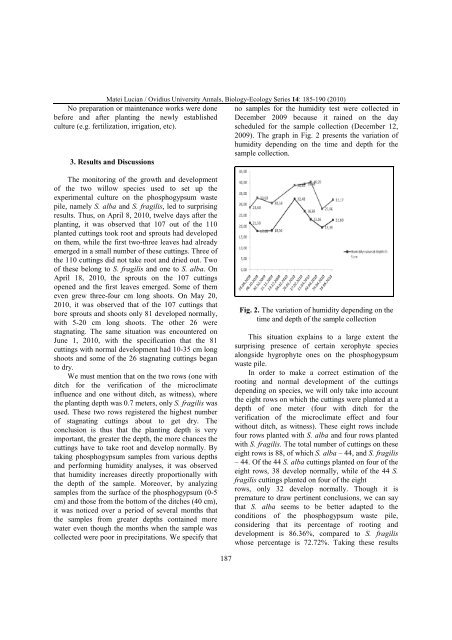VOLUM OMAGIAL - Facultatea de Ştiinţe ale Naturii şi Ştiinţe Agricole
VOLUM OMAGIAL - Facultatea de Ştiinţe ale Naturii şi Ştiinţe Agricole
VOLUM OMAGIAL - Facultatea de Ştiinţe ale Naturii şi Ştiinţe Agricole
You also want an ePaper? Increase the reach of your titles
YUMPU automatically turns print PDFs into web optimized ePapers that Google loves.
Matei Lucian / Ovidius University Annals, Biology-Ecology Series 14: 185-190 (2010)<br />
No preparation or maintenance works were done<br />
before and after planting the newly established<br />
culture (e.g. fertilization, irrigation, etc).<br />
3. Results and Discussions<br />
The monitoring of the growth and <strong>de</strong>velopment<br />
of the two willow species used to set up the<br />
experimental culture on the phosphogypsum waste<br />
pile, namely S. alba and S. fragilis, led to surprising<br />
results. Thus, on April 8, 2010, twelve days after the<br />
planting, it was observed that 107 out of the 110<br />
planted cuttings took root and sprouts had <strong>de</strong>veloped<br />
on them, while the first two-three leaves had already<br />
emerged in a small number of these cuttings. Three of<br />
the 110 cuttings did not take root and dried out. Two<br />
of these belong to S. fragilis and one to S. alba. On<br />
April 18, 2010, the sprouts on the 107 cuttings<br />
opened and the first leaves emerged. Some of them<br />
even grew three-four cm long shoots. On May 20,<br />
2010, it was observed that of the 107 cuttings that<br />
bore sprouts and shoots only 81 <strong>de</strong>veloped normally,<br />
with 5-20 cm long shoots. The other 26 were<br />
stagnating. The same situation was encountered on<br />
June 1, 2010, with the specification that the 81<br />
cuttings with normal <strong>de</strong>velopment had 10-35 cm long<br />
shoots and some of the 26 stagnating cuttings began<br />
to dry.<br />
We must mention that on the two rows (one with<br />
ditch for the verification of the microclimate<br />
influence and one without ditch, as witness), where<br />
the planting <strong>de</strong>pth was 0.7 meters, only S. fragilis was<br />
used. These two rows registered the highest number<br />
of stagnating cuttings about to get dry. The<br />
conclusion is thus that the planting <strong>de</strong>pth is very<br />
important, the greater the <strong>de</strong>pth, the more chances the<br />
cuttings have to take root and <strong>de</strong>velop normally. By<br />
taking phosphogypsum samples from various <strong>de</strong>pths<br />
and performing humidity analyses, it was observed<br />
that humidity increases directly proportionally with<br />
the <strong>de</strong>pth of the sample. Moreover, by analyzing<br />
samples from the surface of the phosphogypsum (0-5<br />
cm) and those from the bottom of the ditches (40 cm),<br />
it was noticed over a period of several months that<br />
the samples from greater <strong>de</strong>pths contained more<br />
water even though the months when the sample was<br />
collected were poor in precipitations. We specify that<br />
187<br />
no samples for the humidity test were collected in<br />
December 2009 because it rained on the day<br />
scheduled for the sample collection (December 12,<br />
2009). The graph in Fig. 2 presents the variation of<br />
humidity <strong>de</strong>pending on the time and <strong>de</strong>pth for the<br />
sample collection.<br />
Fig. 2. The variation of humidity <strong>de</strong>pending on the<br />
time and <strong>de</strong>pth of the sample collection<br />
This situation explains to a large extent the<br />
surprising presence of certain xerophyte species<br />
alongsi<strong>de</strong> hygrophyte ones on the phosphogypsum<br />
waste pile.<br />
In or<strong>de</strong>r to make a correct estimation of the<br />
rooting and normal <strong>de</strong>velopment of the cuttings<br />
<strong>de</strong>pending on species, we will only take into account<br />
the eight rows on which the cuttings were planted at a<br />
<strong>de</strong>pth of one meter (four with ditch for the<br />
verification of the microclimate effect and four<br />
without ditch, as witness). These eight rows inclu<strong>de</strong><br />
four rows planted with S. alba and four rows planted<br />
with S. fragilis. The total number of cuttings on these<br />
eight rows is 88, of which S. alba – 44, and S. fragilis<br />
– 44. Of the 44 S. alba cuttings planted on four of the<br />
eight rows, 38 <strong>de</strong>velop normally, while of the 44 S.<br />
fragilis cuttings planted on four of the eight<br />
rows, only 32 <strong>de</strong>velop normally. Though it is<br />
premature to draw pertinent conclusions, we can say<br />
that S. alba seems to be better adapted to the<br />
conditions of the phosphogypsum waste pile,<br />
consi<strong>de</strong>ring that its percentage of rooting and<br />
<strong>de</strong>velopment is 86.36%, compared to S. fragilis<br />
whose percentage is 72.72%. Taking these results





